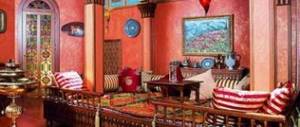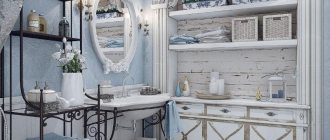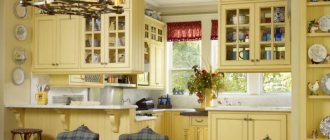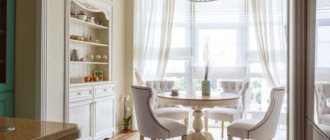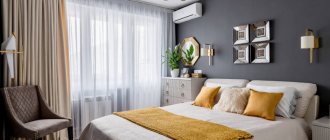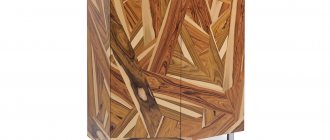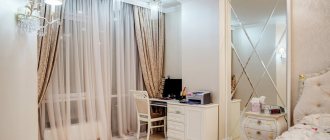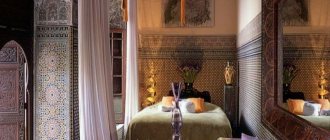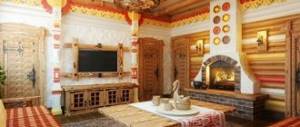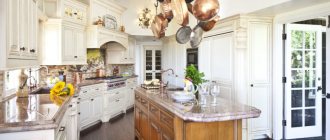Features of the rustic style
The word “rustic” itself, translated from French, means “rustic”, “rural”, “rough”. This style arose naturally when immigrants from cities began to leave old furniture practically unchanged when entering village houses.
In general, this direction is characterized by the following features:
- Use of natural materials. Wood, stone and metal are used to decorate walls, floors and ceilings. It is desirable that all materials have a rough, unprocessed texture.
- Minimalism and simplicity. Rustic does not tolerate stucco, abundant carvings on furniture and painted elements.
- Space. The rustic style fits best into the interior of large rooms. It is in such an interior that you can decorate the ceiling with beams and decorate the walls with rather massive materials.
- Widespread use of ceramics. Dishes are used not only for their intended purpose - clay pots and plates are displayed on shelves as decoration.
- Decorating the room with elements of rustic life. For this purpose, coarse-cut napkins, coarse-knitted blankets, simple small-sized carpets, grips, etc. are used.
- Using a warm color palette. The dominant color for a rustic kitchen is light wood. Additional tones include various shades of brown, yellow, ocher and white.
- Soft lighting. It is not recommended to use fluorescent lamps to decorate a rustic kitchen. In extreme cases, such lamps are only suitable for illuminating work surfaces.
- Heavy curtains. Unlike country and Provence styles, a rustic interior does not tolerate light and airy curtains, and tulle is also unacceptable.
- Widespread use of aging technologies. Wood and metal are covered with patina in such an interior; abrasions, scratches and wormholes are artificially created on the countertops.
Design ideas
Warm and natural colors
To visualize antiquity in interior design, the use of warm colors is of great importance. The main emphasis is on the surface of the walls and ceiling, decorative elements, curtains.
There is no need to stick to only brown (wood) or gray (stone) colors. Shades of red, yellow and orange will fit perfectly into the natural design.
There are many gorgeous bright shades in nature, but the typical rustic style works best with more muted tones.
For example, the rooms are furnished in sand-colored furniture, and the walls are painted in a richer earthy brown shade. These natural colors calm you down and set you up for an optimistic perception of the world around you.
Paneled or white walls
A paneled wall will provide both an architectural and acoustic advantage, providing aesthetics and cozy silence.
Simple white walls are a great blank canvas for working with rustic decor. This is a great opportunity to realize your own ideas.
Raw natural elements
This is perhaps the most important feature of a modern rustic country interior. Fans of such solutions usually want to bring nature inside.
For example, if the house is old, it is important to preserve the character and original architectural details. If you are building a new one, you can immediately expose the beams, use wood or wood materials in the decoration, or make a stone fireplace.
Modern rustic interiors never forget about the fifth wall - the ceiling. Frame houses with wooden ceilings or large beams are quite popular and give a truly rustic look.
Rough wooden beams
This architectural element has become the essence of rustic design. Open-air ceilings were an integral part of the ceiling in older homes, and they are now becoming popular again.
They can be used to frame ceilings, delimit doors, windows, and highlight a fireplace. They can be in the form of round, less often - square logs, always massive and reliable.
Window
Large windows are another important feature of rustic homes. In fact, it is a feature that suits both rustic interiors and modern comfort requirements, making it a crucial component of the rustic style.
Since a modern home is always open and full of light, it is important to make the windows so that they bring the inside together with the outside, so that the space of the house or apartment is as close to the street as possible.
More: Interior design in the style of Diane de Poitiers
Organic decorative elements
Accessories in keeping with the current theme of the past add charm and simplicity to a rustic interior. The principle “I made him out of what was” works well here.
It can be:
- wire baskets turned into lamps,
- wooden boxes that became steps of the stairs,
- old blinds transformed into works of art through hand painting.
All this will create a feeling of serenity and peace, “homeliness” and antiquity.
Texture fabrics
Fabrics used for rustic interiors must be natural, rough, strong and wear-resistant:
- linen,
- sackcloth,
- cotton,
- wool, etc.
They are used for upholstery of furniture, bed linen, paths; instead of carpets, animal skins are used. Thin textiles, silk and lace are inappropriate.
Advantages and disadvantages
Like any direction, the rustic style has its pros and cons. The advantages of a kitchen made in a rustic style include the following interior features:
- environmental friendliness of the materials used;
- natural wood does not suffer as much from temperature changes as modern materials;
- the kitchen set lasts longer, since all scuffs, scratches and slight defects only enhance the effect of antiquity and wear, which is one of the key features of the rustic style for kitchen decoration;
- Many decorative elements for a rustic kitchen can be made with your own hands; this will only give the kitchen a special rustic charm.
Although we have long grown out of childhood, we still have a longing for our own secluded refuge, in which we will feel as safe as possible. A bed with a canopy frame is ideal for this purpose.
The disadvantages of rustic design include the high cost of natural materials and high-quality substitutes. In addition, the direction imposes some restrictions on small rooms. In particular, in a kitchen with low ceilings, you cannot install beams and attach a heavy pendant chandelier - these elements will make the room even smaller and overload the space.
Color palette
In a rustic kitchen, wood tones should predominate. Spacious kitchens can be decorated in any color palette of this spectrum, however, small rooms are best decorated with light materials.
Dominant colors in rustic style:
- dark and light wood;
- ocher;
- black;
- grey;
- white;
- beige.
To visually add space in a small kitchen, in addition to minimalism in furniture, use light colors in the decor.
Sometimes an olive-colored or bluish kitchen set, if it is artificially aged, fits well into the kitchen interior.
Rustic kitchen decoration
The main finishing material for a rustic kitchen is rough untreated wood or wood with a very basic finish. The shade of wood can be very different, and you can use both boards and whole beams.
The most popular wood species for rustic style:
- pine;
- cherry;
- oak;
- nut.
Metal is used as an additional finishing material.
The rustic style is characterized by the use of forged chandeliers, candlesticks, lamps and metal fittings. It is important to avoid aluminum and chrome-plated structures. Bronze, brass and cast iron are best suited for interiors in this area. Important! Plastic cannot be used in a rustic kitchen, nor can chipboard.
Ceiling
The decoration of the ceiling in a rustic kitchen depends on the height of the room:
Rustic in details: advice from designers
To create a home that will be a pleasure to live in, listen to the advice of experienced designers who know not only the theoretical foundations of creating a rustic interior, but also have extensive experience in translating this knowledge into real objects. They have prepared a whole list of tips and recommendations for you:
- Of the light brown shades of wood, the colors of walnut, white maple and alder , and from the dark brown range - wenge, cherry, oak and beech.
- Think about what furniture that has been stored in the attic for years looks like to imagine the look of ideal rustic furniture. These are worn surfaces with traces of knots that can only be treated for pest control purposes. .
- Rough boards and old doors are suitable materials for making furniture. If you have woodworking skills, you can make a rustic kitchen table with your own hands.
- Do not buy furniture with ornaments for rustic. Even if you can age it using several methods, the patterns will not fit into the rough environment.
- In addition to wood, the rustic style is characterized by the use of natural stone
, fabric, and much less often, metal as fittings or small finishing elements (handles on cabinets, for example). For stone, choose sandstone and quartz, and for fabric, buy homespun fabric with a rough texture.
- If there is enough space for a fireplace in a rustic living room, it will be a desirable part of such an interior. However, it should be stylized as an old hearth , on which food was cooked, and not just used as heating.
- Wallpapers of cream, sand and other light shades without patterns are often used for pasting walls. Instead of wallpaper, the walls can be painted with light paint, additionally finishing them with stone and wood. Almost any combination of natural materials is allowed, but the use of modern techniques and technologies (stretch ceilings and other innovations) is strictly prohibited.
- You can lay rough boards
or decorative stone on the floor in the room. The first option, of course, will be warmer, because you will always have to walk on stone flooring in shoes or indoor slippers. - The contrast for the light walls will be the dark beams on the ceiling.
- Absent from a rustic interior are bright colors, glossy surfaces and complex shapes.
- If you like to decorate your home, buy an antique-style candlestick, a cupronickel vase, a large chest, and silver cutlery.
Decoration of window openings
Simple, unpainted wooden frames fit best into a rustic interior. Additionally, they are decorated with rather heavy curtains - light tulle and lace are strictly prohibited from being used in such a kitchen, unlike in country style. Draping curtains is also prohibited.
Coarse fabrics are best suited as textile materials:
- mat;
- homespun fabrics;
- unbleached linen.
Window sills are usually decorated with clay pots with fresh flowers, however, it is advisable not to use too exotic plants as decoration.
Wood is the main component of style
Wood is an important part of the rustic style, without which you cannot decorate any room or celebration in this style. Preferred colors are the whole range of shades from light brown to dark brown . If color is not so important, then more demands are placed on appearance. The older the tree looks, the better. All visible flaws, such as unevenness, cracks, small chips and scratches, are rather advantages. All traces of the impact of time on wood only play into your hands, because such an interior will be simply perfectly “rusticized”. As for the type of wood, cherry, alder, pine, maple, beech and luxurious oak are especially popular among designers.
In a rustic interior, the use of the following room design elements is not encouraged:
- elaborately shaped furniture items;
- glossy and highly polished surfaces;
- too wide variety of colors and bright shades;
- geometric patterns and ornaments.
Furniture selection
The rustic style implies simplicity, good quality and naturalness in the interior, so glass and plastic in furniture will have to be abandoned, as well as other modern materials.
It is better to choose a dining table from among heavy and massive models made of natural wood. Around the table there are stools of a rather rough design or long benches. Chairs in the form of solid stumps with minimal processing fit especially well into a rustic kitchen.
Coffee table from a pallet in the living room. Making a coffee table from regular wooden pallets is extremely easy. You will complete this project in literally one weekend. It will add rustic charm and originality to your living room.
The rest of the kitchen set should also be of good quality and slightly rough, however, such furniture is not suitable for all rooms. In a small kitchen, it is better to replace massive cabinets with shelves.
Important! Lacquer coatings in a rustic kitchen are unacceptable, as well as any shine or gilding. Any wood processing should be light and superficial. Two-color headset models can be used, but in general this is not advisable.
It is not always possible to purchase an antique kitchen set due to its high cost, however, you can always buy artificially aged furniture. To do this, the wood is covered with a patina of discreet shades, as a result of which the set takes on a slightly worn-out appearance.
How did the rustic style come about?
The rustic style in the interior appeared and began to be used in the middle of the last century. This is a modified analogue of the American country style with elements of a Russian hut. It is believed that this style originated in the United States and immediately became the traditional style of decorating the homes of middle-class people. Gradually, the upper strata of society began to use the rustic style. In contrast to all modern styles with their abundance of glass and plastic, concrete and chrome parts, bright colors and artificial materials, the rustic style is associated with a cowboy ranch, the smell of wood, cozy evenings by the fireplace and other pleasant moments of life.
Kitchen with an island in a rustic style Kitchen with an island and a breakfast bar in a rustic style Furniture in a bright living room in a rustic style Bedroom in a rustic style Fireplace in a living room in a rustic style Interior of a house in a rustic style
Appliances
Rustic does not tolerate emphasized modern interior elements, so all household appliances are hidden behind wooden facades or artificially aged. What cannot be hidden (stove, refrigerator) is selected taking into account the color palette of the interior. For example, a copper or bronze colored refrigerator will fit well into the abundance of warm wood tones. Also, household appliances decorated in a metallic look go well with a rustic kitchen.
Lighting
The rustic style in the kitchen interior is characterized by soft diffused lighting. Heavy pendant chandeliers made of wood or metal are used as the main light source. It is advisable to paint forged models in dark colors, most often black. Bronze, darkened silver or nickel colors are also suitable.
It is customary to complement work areas in the kitchen with spotlights that echo or match the style of the chandelier. Rough clay lampshades and wicker lampshades complement the rustic style well. The latter can also be decorated with twine.
Ordinary candles of different sizes look beautiful as a source of additional light, however, they should be handled with extreme caution to avoid fire. If you wish, you can always make a suitable lamp yourself. To do this, you will need rough cuts of wood and branches, cones, rattan and a forged or wooden frame.
Decor and accessories
The interior of a kitchen in an apartment or private house in a rustic style should be thought out to the smallest detail, including its filling with accessories. Incorrectly chosen decor can disrupt the overall atmosphere of antiquity in the room, so authentic items, antiques and accessories purchased at flea markets are best suited for rustication. In particular, the following decorative elements would be a good solution:
Glass fireplace in the dining room. A fireplace is a wonderful focal point in any home. If your home is dominated by Art Nouveau or contemporary design, then a glass fireplace mounted directly into the wall will suit you. The best place for it would be a partition separating the living area from the dining room.
- heavy forged candlesticks, wall or table;
- old mortars;
- wicker baskets;
- antique clock;
- old massive chest;
- spice jars;
- clay dishes;
- bunches of dried vegetables;
- warm blankets;
- linen napkins.
Important! The rustic style does not combine with patterns of geometric shapes, overly shiny surfaces, elaborate carvings on kitchen furniture and bright colors. They can be present in the kitchen as accents, but calm, warm tones should dominate.
Rustic kitchen interior design ideas
Very often the rustic style is confused with others:
- country;
- Provence;
- loft;
- Scandinavian.
While this direction is very different from them. In order not to accidentally dilute the decor in the rustic style with elements of other styles, it is recommended to familiarize yourself with the most successful design solutions in this area.
Distinctive features of the rustic style
Let's take a closer look at all the features of the rustic style.
As mentioned earlier, in the rustic style it is allowed to use only natural materials. But these are not materials of ideal appearance and shape, but absolutely natural, unprocessed natural materials that have retained even their flaws.
Kitchen-dining room in rustic style
- The main element of the rustic style is wood. There should be a lot of it and it should be unsanded and not subject to any treatment other than for the purpose of protection from pests. All cracks, irregularities, nicks, knots, and signs of time must be present on the wood. Moreover, if the tree is not old, then it is artificially “aged” and even wormholes are created with a special device. Ceiling beams, furniture, floors, windows, doors - everything should be made of wood. Even wooden dishes and decorative items are welcome. The color of the wood can vary from light brown - walnut, maple, alder to darker tones - pine, cherry, beech, oak.
- Another important element of the rustic style is stone. The stone must also be natural, not subject to processing. The most commonly used stones are quartz, sandstone, limestone, as well as granite and marble.
- Although metal in a rustic style does not play a leading role, it must still be present in the interior. Kitchen utensils, forged candlesticks, cutlery are an important decorative element. The metal should be old and dark. Bronze, brass, cast iron, silver and cupronickel are best suited for this. You can also use stainless steel, previously artificially “aged”.
- The walls of a room in a rustic style are usually finished with wood or stone. It is also possible to cover them with white paint. In this case, deliberate negligence and rough brush marks are very desirable. And only occasionally light wallpaper is used to decorate the walls. Untreated boards or decorative stone are placed on the floor.
- The ceiling in a rustic style should be beamed. In this case, whether the beams are real or simulated - it doesn’t matter at all. The color of the ceiling should be contrasting with the color of the walls.
- Windows and doors should look quite rough and visually inspire reliability. And of course the material for their manufacture is wood. No metal-plastic!
- The rustic style in the interior necessarily requires the presence of a fireplace. A cozy rustic fireplace, or rather even a hearth, is the heart of the house. In ancient times, such a hearth warmed the house, cooked food and gathered the whole family around it on cold evenings.
- The color palette of the rustic style is discreet, natural, warm and cozy. These are all shades of brown, black, white, gray. And also beige, sand, ocher, marsh and muted red shades. The brightness of color and ornaments are completely inappropriate in this style.
- Fabrics used in rustic style must be natural. Usually these are linen fabrics of soft natural colors without patterns, with the exception of ethnic patterns. The presence of homespun fabric elements in the interior is highly desirable. Synthetics should be absolutely avoided!
- As decorative accessories in a rustic interior, you can use ceramics, wicker baskets, glass and wooden trinkets, forged candlesticks and souvenirs, homemade lace napkins and towels, bouquets of dried flowers or fresh wildflowers. Also, for example, an antique chest or barrel would look quite harmonious.
- Today it is impossible to imagine your home without the fruits of civilization - lighting, communications, and various household appliances. All this, of course, can be used in a rustic style. True, it is better to disguise and hide all electrical appliances and all equipment. For this case, many techniques have been developed - masking cabinets and various hiding panels.
Unusual materials for a rustic kitchen
Kitchen with an island and a decorated hood in a rustic style Children's room in a rustic style Luxurious bedroom in a rustic style Modern interior in a rustic style Living room with a large window in a rustic style
